Double Block And Bleed(DBB) Valve Design and Features
1. Double Block And Bleed(DBB)
When the valve is closed and the middle cavity is emptied through the discharge valve, the upstream and downstream seats will independently block the fluid at the inlet and outlet to realize double block function. Another function of the discharge device is that the valve seat can be checked if there is any leakage during the test. In addition, the deposits inside the body can be washed and discharged through the discharge device to reduce damage to the seat by impurities in the medium.
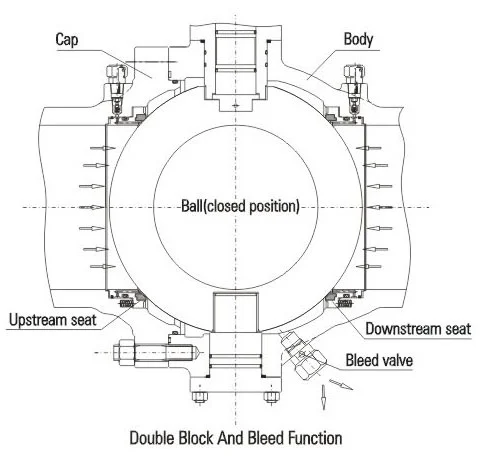
2. Low Operating Torque
The trunnion pipeline ball valve adopts the trunnion ball structure and floating valve seat, so as to achieve lower torque under operating pressure. It uses self-lubricating PTFE and sliding bearing to reduce the friction coefficient to the lowest in conjunction with the high intensity and high fineness stem.
3. Emergency Sealing Device
The ball valves with the diameter more than or equal to 6″(DN150) are all designed with sealant injection device on stem and seat. When the seat ring or stem O ring is damaged due to accident, the corresponding sealant can be injected by the sealant injection device to avoid medium leakage on seat ring and stem. If necessary, the auxiliary sealing system can be used for washing and lubricating the seat to maintain its cleanliness.
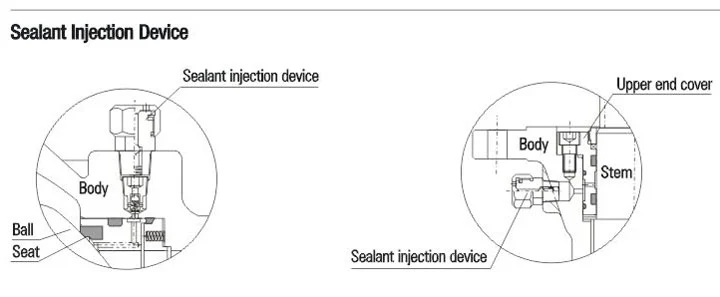
4. Fireproof Structure Design
In case of fire during the use of valve, the seat ring, stem O ring and middle flange O ring made of PTFE, rubber or other non-metal materials will be decomposed or damaged under high temperature. Under pressure of the medium the ball valve will push the seat retainer rapidly towards the ball to make the metal seal ring contact the ball and form the auxiliary metal to metal sealing structure, which can effectively control valve leakage. The fireproof structure design of trunnion pipeline ball valve conforms to requirements in API 607,API 6FA,BS 7655 and other standards.
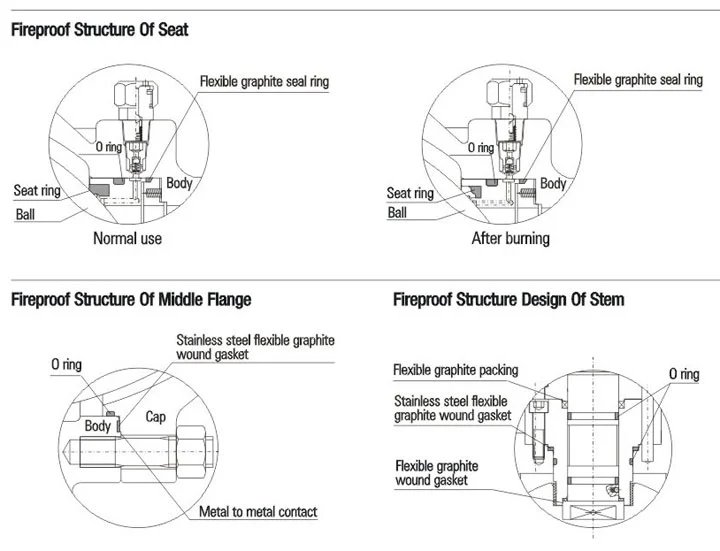
5. Anti-static Structure
The ball valve is provided with the anti-static structure and adopts the static electricity discharge device to directly form a static channel between the ball and body or form a static channel between the ball and body through the stem, so as to discharge the static electricity produced dut to friction during the opening and closing of ball and seat through the pipeline, avoiding fire or explosion that may be caused by static spark and ensuring system safety.
6. Reliable seat sealing structure
The seat sealing is realized through two floating seat retainers. They can float axially to block the fluid, including ball sealing and body sealing. The low pressure sealing of valve seat is realized by spring pre-tightening. In addition, the piston effect of valve seat is desinde reasonably, which realizes high pressure sealing by the pressure of the medium itself. The following two kinds of ball sealing can be realized.
7. Single Sealing (automatic Pressure Relief In Middle Cavity Of Valve)
Generally, the single sealing structure is used, that is, there is only the upstream sealing. As the independent spring loaded upstream and downstream sealing seats are used, the over-pressure inside valve cavity can overcome the pre-tightening effect of the spring, so as to make the seat release from the ball and realize automatic pressure relief towards the downstream part.
The upstream side: When the seat moves axially along the valve, the pressure P exerted on the upstream part(inlet) produces a reverse force on A1. As A2 is higher than A1, A2-A1=B1, the force on B1 will push the seat to the ball and realize tight sealing of the upstream part.
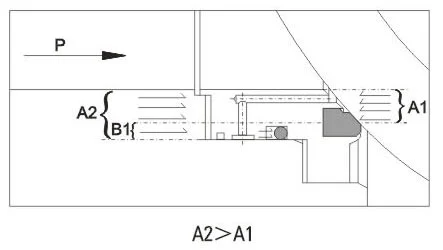
The downstream side: Once the pressure Pb inside the valve cavity increases, the force exerted on A3 is higher than that on A4.As A3-A4=B2, the pressure differential on B2 will overcome the spring force to make the seat release from the ball and realize pressure relief of valve cavity to the downstream part. Afterwards, the seat and ball will be sealed again the spring action.
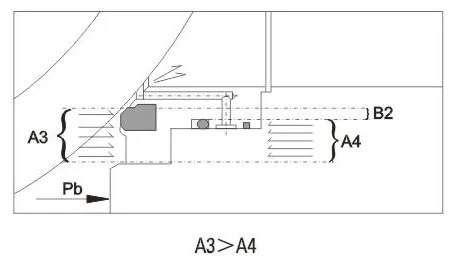
8. Double Sealing (double Piston)
The trunnion pipeline ball valve can be designed with the double sealing structure before and after the ball for some special service conditions and user requirements. It has double piston effect. Under normal condition, the valve generally adopts primary sealing. When the primary seat sealing is damaged and causes leakage. The secondary seat can play the function of sealing and enhance the sealing reliability.
The seat adopts the combined structure. The primary seal is metal to metal seal. The secondary seal is fluorine rubber O ring that can ensure the ball valve reach the bubble level sealinge . When the pressure differential is very low, the sealing seat will press the ball through the spring action to realize primary sealing. When the pressure differential rises, the sealing force of seat and body will increase accordingly so as to tightly seal the seat and ball and ensure good sealing performance.
Primary sealing: Upstream. When the pressure differential is lower or there is no pressure differential, the floating seat will move axially along the valve under the spring action and push the seat towards the ball to keep tight sealing. When the pipeline pressure P increases, the force exerted on the area A2 of valve seat is higher than the force exerted on the area A1, A2-A1=B1. Therefore, the force on B1 will push the seat towards the ball and realize tight sealing of the upstream part.
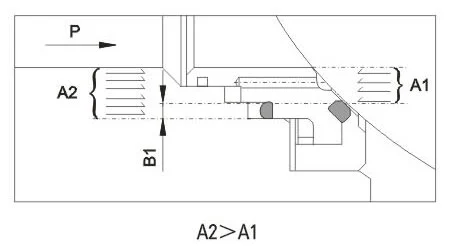
Secondary sealing: Downstream. When the pressure differential is lower or there is no pressure differential, the floating seat will move axially along the valve under the spring action and push the seat towards the ball to keep tight sealing. When the valve cavity pressure P increases, the force exerted on the area A4 of valve seat is higher than the force exerted on the area A3,A4-A3=B1. Therefore, the force on B1 will push the seat towards the ball and realize tight sealing of the upstream part.
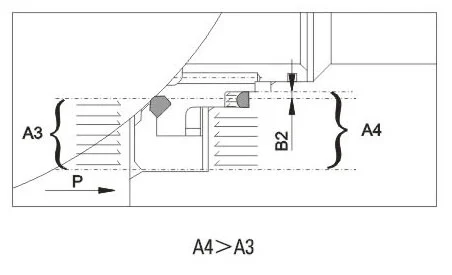
9. Safety Relief Device
As the ball valve is designed with the advanced primary and secondary sealing that has double piston effect, and the middle cavity cannot realize automatic pressure relief, the safety relief valve must be installed on the body in order to prevent the danger of over-pressure damage inside the valve cavity that may occur due to thermal expansion of medium. The connection of the safety relief valve is generally NPT1/2. Another point to be noted is that the medium of the safety relief valve is directly discharged into the atmosphere. In case direct discharging into the atmosphere is not allowed, we suggest that the ball valve with a special structure of automatic pressure relief towards upper stream should be used. Refer to the following for details. Please indicate it in the order if you don not need the safety relief valve or if you would like to use the ball valve with the special structure of automatic pressure relief towards upper stream.
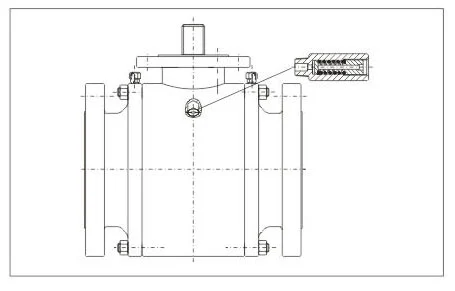
10. Secial Structure Of Automatic Pressure Relief Towards Upper Stream
As the ball valve is designed with the advanced primary and secondary sealing that has double piston effect, and the middle cavity cannot realize automatic pressure relief, the ball valve with the special structure is recommended to meet the requirement of automatic pressure relief and ensure no pollution to the environment. In the structure, the upper stream adopts primary sealing and the lower stream adopts primary and secondary sealing. When the ball valve is closed, the pressure in the valve cavity can realize automatic pressure relief to the upper stream, so as to avoid the danger caused by cavity pressure. When the primary seat is damaged and leaks, the secondary seat can also play the function of sealing. But special attention shall be paid to the flow direction of the ball valve. During the installation, note the upstream and downstream directions. Refer to the following drawings for sealing principle of the valve with the special structure.
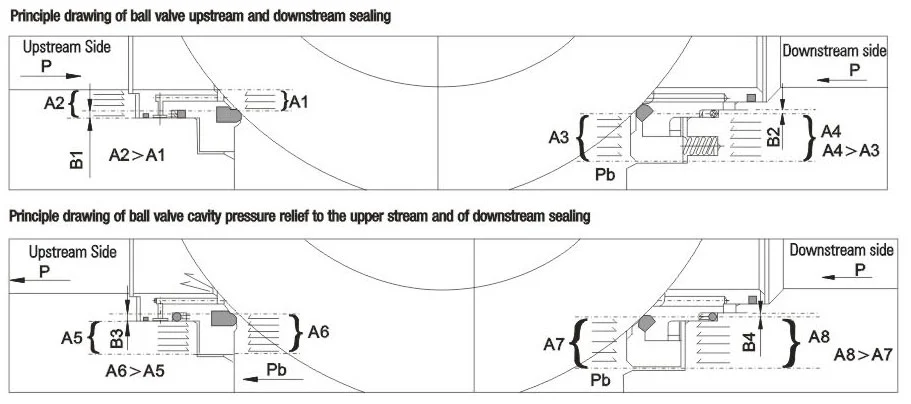
11. Blow-out Proof Stem
The stem sdopts the blow-out proof structure. The stem is designed with the footstep at its bottom so that with the positioning of upper end cover and screw, the stem will not be blown out by the medium even in case of abnormal pressure in the valve cavity.
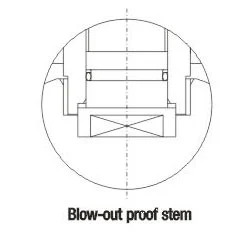
12. Corrosion Resistance And Sulfide Stress Resistance
Certain corrosion allowance is left for the body wall thickness. The carbon steel stem, fixed shaft, ball, seat and seat ring are subjected to chemical nickel plating according to ASTM B733 and B656. In addition, various corrosion resistant materials are available for users to select.
According to customer requirements, the valve materials can be selected according to NACE MR 0175/ISO 15156 or NACE MR 0103, and strict quality control and quality inspection should be carried out during the manufacturing so as to fully meet he requirements in the standards and meet the service conditions in sulfurization environment.